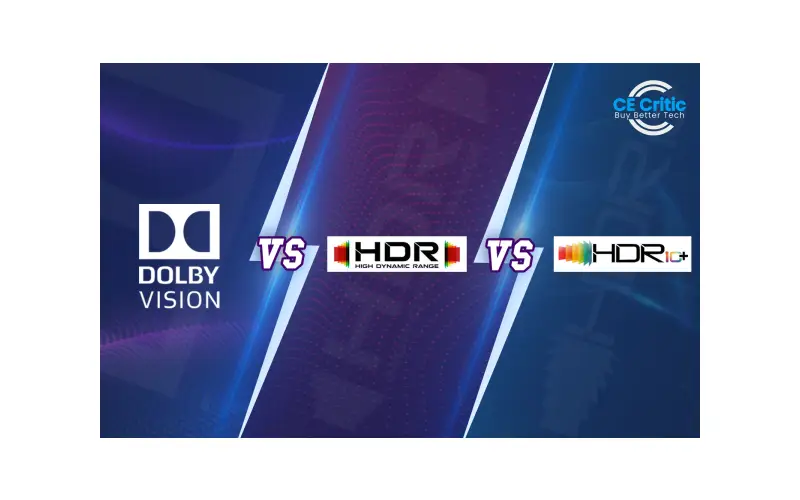By CE Critic - Buy Better Tech
Table of Contents:
- Unveiling the Curtain: What is HDR?
- The Brightness Revolution: HDR10 - The Foundation
- HDR10+ vs. Dolby Vision: A Battle of Dynamic Tones
- HDR Showdown: Strength by Strength
- Choosing Your Champion: Which HDR Format Rules Your Home Theater?
- Beyond the Horizon: What's Next for HDR?
Unveiling the Curtain: What is HDR?
Imagine watching a movie where shadows burst with detail, sunlight gleams with lifelike intensity, and explosions erupt with breathtaking realism. That's the magic of HDR, or High Dynamic Range. Stepping beyond the limitations of standard dynamic range (SDR) visuals, HDR unlocks a wider spectrum of brightness, contrast, and color, painting a picture closer to what our eyes experience in the real world.
The Brightness Revolution: HDR10 - The Foundation
The HDR story begins with HDR10, the industry's baseline format. Launched in 2015, HDR10 sets a static high peak brightness level (typically 1,000 nits) for the entire film or show. This means all scenes benefit from increased brightness, regardless of their individual light and dark elements. While HDR10 delivers a significant jump in picture quality compared to SDR, its static approach can occasionally lead to clipped highlights or crushed blacks in scenes with extreme contrasts.
HDR10+ vs. Dolby Vision: A Battle of Dynamic Tones
Enter HDR10+ and Dolby Vision, the dynamic duo challenging HDR10's throne. Unlike their static counterpart, these formats analyze each scene individually, adjusting the peak brightness and contrast levels on a frame-by-frame basis. This dynamic approach allows for more nuanced rendering of light and shadow, preserving details in both the brightest highlights and the darkest blacks.
HDR Showdown: Strength by Strength
Let's pit these powerful formats against each other:
| Feature | HDR10 | HDR10+ | Dolby Vision |
|
Dynamic Tone Mapping
|
No | Yes | Yes |
|
Peak Brightness
|
Static (1,000 nits) | Varies per scene | Varies per scene (up to 10,000 nits) |
|
Color Gamut
|
Rec. 2020 | Rec. 2020 | Rec. 2020 |
|
Open Standard
|
Yes | Yes | No |
| Adoption Rate | Widely supported | Gaining traction |
Widely supported
|
Choosing Your Champion: Which HDR Format Rules Your Home Theater?
The choice between HDR formats depends on your priorities and setup. HDR10 offers a solid entry point with its widespread support and open-source nature. HDR10+ delivers similar dynamic tone mapping benefits as Dolby Vision but faces limited device compatibility. Dolby Vision boasts wider color gamut and potential for higher peak brightness, but requires Dolby licensing and compatible hardware.
HDR10+ also uses a 10-bit color depth and a wider color gamut, similar to HDR10. However, with dynamic metadata, HDR10+ can provide better performance in varying lighting conditions, making it a more adaptable HDR format. HDR10+ is gaining popularity and is supported by a growing number of TVs, Blu-ray players, and streaming services.
Another notable feature of Dolby Vision is its support for a 12-bit color depth, which allows for an even wider range of colors and greater detail compared to HDR10 and HDR10+. However, it's worth noting that not all Dolby Vision content is mastered in 12-bit, as it depends on the production workflow and the capabilities of the display device.
Ultimately, the ideal HDR format is the one that best fits your budget and streaming habits. Research your potential TV, streaming services, and film libraries to see which format reigns supreme in your home theater kingdom.
Beyond the Horizon: What's Next for HDR?
The HDR story continues to evolve with advancements like HDR10+ Adaptive and Dolby Vision IQ, further refining dynamic tone mapping for even more accurate and immersive visuals. As display technology continues to improve, pushing the boundaries of brightness and color reproduction, we can expect even more breathtaking HDR experiences in the future.
So, dive into the world of HDR and witness the breathtaking evolution of picture quality. From the solid foundation of HDR10 to the dynamic brilliance of HDR10+ and Dolby Vision, choose your champion and let the vibrant colors and dazzling details illuminate your home theater!





